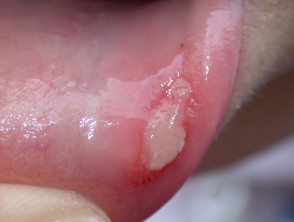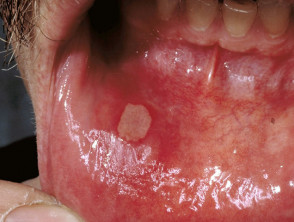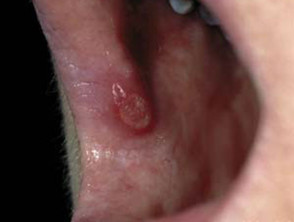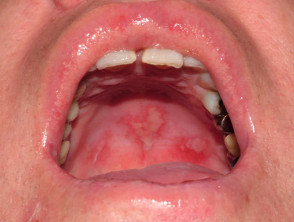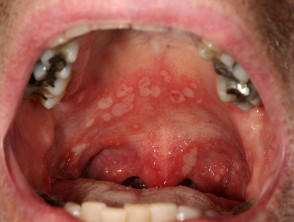What is an aphthous ulcer?
An aphthous ulcer is the most common ulcerative condition of the oral mucosa, and presents as a painful punched-out sore on oral or genital mucous membranes. They are also called aphthae, aphthosis, aphthous stomatitis and canker sores.
Who gets aphthous ulcers?
Anyone can get an aphthous ulcer; 20% of the population have one or more, at least occasionally. They usually first appear in childhood or adolescence, and more commonly affect females than males.
Aphthous ulcers can be an early manifestation of a systemic disease such as Behçet disease, or gastrointestinal disorders including coeliac disease, Crohn disease, and ulcerative colitis. Aphthous stomatitis is a feature of the recurrent fever syndrome PFAPA syndrome.
Interestingly, smoking may be protective against aphthae, even though smoking makes many oral and skin conditions worse.
What causes an aphthous ulcer?
The exact reason why aphthous ulcer develops is not yet clearly defined. Approximately 40% of people who get aphthous ulcers have a family history of aphthous ulcers. Current thinking is that the immune system is disturbed by some external factor and reacts abnormally against a protein in mucosal tissue.
Factors that seem to trigger outbreaks of ulcers include:
- Emotional stress and lack of sleep
- Mechanical trauma, for example, self-inflicted bite
- Nutritional deficiency, particularly of vitamin B, iron, and folic acid
- Certain foods, including chocolate
- Certain toothpastes; this may relate to sodium laureth sulphate (the foaming component of toothpaste)
- Menstruation
- Certain medications, including nicorandil, given for angina
- Viral infections.
What are the clinical features of an aphthous ulcer?
An aphthous ulcer is typically a solitary round or oval punched-out sore or ulcer inside the mouth on an area where the mucosa is not tightly bound to the underlying bone, such as on the inside of the lips and cheeks or underneath the tongue. Aphthous ulcers can also affect the genitalia in males and females.
Recurrent aphthous ulcer usually begins as a round yellowish elevated spot surrounded by a red halo. This then breaks down into a punched-out ulcer, which is covered with a loosely attached white, yellow, or greyish membrane. Surrounding tissue is healthy and unaffected. The ulcer can be painful, particularly if irritated by movement or eating certain types of food such as citrus fruit.
People may experience a single ulcer or multiple ulcers. Multiple ulcers tend to be widely distributed throughout a person's mouth.
Aphthous ulceration is classified into three types.
- Recurrent minor aphthous ulcer (80%). This is less than 5 mm in diameter and heals within 1–2 weeks.
- Major aphthous ulcer, which is large (often more than 10 mm) and takes weeks or months to heal and leaves a scar.
- Herpetiform ulcers, which are multiple pinpoint ulcers that heal within a month. These are most commonly on the tongue.
Minor aphthous ulcers
How is aphthous ulcer diagnosed?
Aphthous ulcers are usually diagnosed clinically. Investigations are rarely required, but are undertaken if there are recurrent attacks of multiple or severe oral ulcers or complex aphthosis.
Blood tests may include:
- Blood count, iron, vitamin B12, and folate studies
- Gluten antibody tests for coeliac disease
- Faecal calprotectin test for Crohn disease.
Swabs for microbiology evaluate the presence of Candida albicans, Herpes simplex virus and Vincent's organisms.
What is the differential diagnosis of aphthous ulcer?
Other causes of mouth ulcer should be considered, including:
- Herpes simplex, hand foot and mouth disease, and other viral infections
- Herpangina
- Erythema multiforme
- Fixed drug eruption.
Differential diagnosis of oral aphthous ulcer
What is the treatment for an aphthous ulcer?
There is no cure for an aphthous ulcer and the ulcers heal spontaneously. The main goal of treatment is to lessen pain and discomfort and promote healing.
General measures
- Protective pastes that form a barrier over the ulcer so that exposure to irritating substances is reduced.
- Superficial tissue cauterisation using silver nitrate stick.
- Local anaesthetics benzocaine and lignocaine (lidocaine) to reduce pain.
- Medicated toothpaste without sodium laureth sulphate.
- Antibacterial mouthwashes to reduce secondary infection.
- Avoidance of foods that trigger or exacerbate the ulcers.
- Treatment of an associated condition or underlying cause, for example -
- Dietary supplements of vitamins or minerals, if the diet is inadequate or a deficiency is identified.
- Reduction in stress.
Prescribed medicines for aphthous ulcer
Topical prescription medicines are rarely required:
- Tetracycline suspension as a mouthwash
- Topical corticosteroids as lotions, creams or paste eg, triamcinolone in dental paste
- Calcineurin inhibitors: topical pimecrolimus or tacrolimus.
In severe cases, particularly if there are systemic symptoms, oral medications with anti-inflammatory activity may be considered (off-label use):
- Tetracycline eg, doxycycline 50-100mg daily for 3-6 months or longer
- Dapsone
- Colchicine
- Systemic steroids
- Immunosuppressive agents such as azathioprine, methotrexate, ciclosporin
What is the outcome of an aphthous ulcer?
Most recurrent minor aphthous ulcers heal within 1–2 weeks without scarring without any treatment. Minor aphthous ulcers commonly recur intermittently.
Recurrent aphthous ulcers are mostly a minor nuisance, but they are associated with significant health problems in some people.
Major aphthous ulcer heals with scarring.
